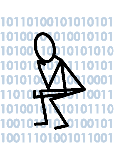
 |
Recommended Readings in HCC |
The Information Age Trilogy:
Vol 1: The Rise of the Network Society
Vol 2: The Power of Identity
Vol 3: The End of Millenium
by Manuel Castells, Blackwell Publishers, Oxford, UK, 1996-98.
Essential reading for an understanding of the implications of computing and communications technologies. Don't be daunted by the size, they're fascinating reading. Consider taking them all on your next vacation... Or consider taking a vacation so that you can read them.
The Invisible Computer
by Donald A. Norman, MIT Press, Cambridge, Mass, 1998.
The latest from the pioneer of human-centered computer design. This book is just out and has already some excellent reviews. Not surprisingly, you'll find the ideas about HCC that you've heard in the seminar in here, plus more. A sharp portrait of ubiquitous computing in context. Its only a book but I swear you can hear someone shouting and banging his fist on the table.
Also by Don Norman:
The Psychology of Everyday Things, Harper-Collins, 1988.
The Design of Everyday Things (paperback version of psychology..) Currency/Doubleday, 1990.
Turn Signals are the Facial Expressions of Automobiles, Perseus Press, 1993.
Things that Make us Smart, Perseus Press, 1994.
Collective Intelligence
by Pierre Levy, Plenum Trade Press, New York 1997.
Piere Levy picks up the streams of "collective intelligence" and "knowledge spaces" found in the work of Doug Englebart and others and develops a fascinating vision of what society could look like if the potential of computing and networking technologies were realized. This is a philosophical/anthropological rather than a technical perspective, but is more far-reaching for that reason .
The Knowledge-Creating Corporation
Ikujiro Nonaka and Hirotaka Takeuchi, Oxford University Press, New York &
Oxford, 1995.
This is already a classic on knowledge management in organizations. It makes a sharp contrast between European and Japanese conceptions of knowledge creation and transfer. It's important to understand the Japanese concept of knowledge, how it contrasts with the western vision embodied in most corporations, and what that implies for the design of collaboration, knowledge- and knowhow-sharing tools.
Also:
California Management Review, Special Issue on Knowledge and the Firm
Robert Cole Ed., Published by the Haas School, UC Berkeley, Spring 1998.
Includes several excellent articles on knowledge in organizations, including one by Nonaka and Konno in which they describe the Japanese concept of "Ba" or abstract place which resonates strongly with Engelbart and Levy's knowledge spaces.
The User Illusion
Tor Norretranders, Viking Publishers & Penguin Books, NY, 1998.
This book is a fascinating study of conscious thought processes and their relationship to preattentive processes. Its relevance for HCC is that it quantifies how little of human information processing is conscious or rational - in other words, computer-like. Then it explores the peculiarities of mostly unconscious (human-like) processors. This book has many strengths. You'll find e.g. a discussion of knowledge vs. information which matches up nicely with Nonaka and Konno's ideas.
Cyberville: Clicks, Culture, and the Creation of an Online
Town (the story of Echo)
Stacy Horn, Warner Books, 1998.
Amy Bruckman's review from Wired says it well: "...rambling, foul-mouthed, and gossipy. It's also hilariously funny and perhaps the most refreshingly insightful, candid portrait of life in cyberspace I've read." I second that. Echo is one of the most intriguing communities around, and the studies in here are sharp, funny, and idealogy-free.
America Calling: A Social History of the Telephone to 1940.
Claude S. Fischer, Univ of California Press, 1994.
This is a wonderful study of how one invention influenced society. Documents the diffusion of the telephone from its invention until 1940. Its fascinating to see how marketing strategies by the phone company shaped the public perception and use of the telephone for years.
Social Network Theory: Methods and Applications (Structural Analysis in the Social Sciences, 8)
by Stanley Wasserman, Katherine Faust, Cambridge Uni. Press, 1994.
This is a good intro. to social network analysis and is very readable for computer scientists. It covers the necessary graph theory completely, and includes high-level descriptions of algorithms as well.
Diffusion of Innovations
by Everett M. Rogers, Free Press, 1995.
Covers diffusion theory in social networks. It's very readable and rich with examples. You don't need to read Wasserman first. It helps a little but this book is self-contained.